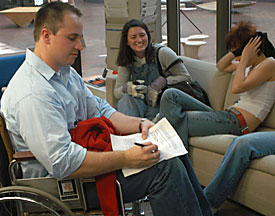 |
|
CHRYSTAL McCONNELL/Arizona Daily Wildcat
|
Architecture students Trevor Buhl (left), Katie MacKinnon (middle), and Alisa Hintz (right) spent yesterday afternoon experiencing what it would be like to be handicapped at UA.
|
|
By Devin Simmons
Arizona Daily Wildcat
Thursday February 20, 2003
Architecture students look for ways to make campus more handicapped-accessible
After two and a half hours of running into signposts, struggling up steep ramps and trying to open doors without using their hands, architecture students have a much better appreciation for what it means to be disabled.
The 53 students in architecture 227, architectural programming, went around campus yesterday with blindfolds, earmuffs, crutches, walkers and wheelchairs in an attempt to simulate physical disabilities.
"The purpose of the exercise is to put people in uncomfortable situations," said Susan Moody, associate dean of the College of Architecture and professor for the class.
"This exercise, and this class, teaches students who are going to be designing buildings to focus on the different kinds of people that will be using the building when it is done. Hopefully, down the road, these students will remember these experiences and become more thoughtful in their design."
The students divided into different groups with different disabilities, and received instructions to go to different buildings and attempt numerous tasks, such as walking up handicap access ramps, using restrooms, purchasing doughnuts at Dunkin' Donuts or browsing Urban Outfitters.
Many of the buildings in the university were built with accessibility standards dating back to the '70s. Since then, there have been many improvements in the technology disabled people use, such as more advanced wheelchairs. But the facilities have not been able to keep up, Moody said.
"People with disabilities are so much more mobile then they used to be," said Gail Bouchee, accessibility coordinator for the Direct Center for Independence, an advocacy center for people with disabilities that has helped provide the equipment to the class for 15 years.
"Advancements in handicap services and technology have come a long way," Bouchee added. "But there is a lot more to do and we have to find innovative ways to meet those challenges. That is what this class is about."
Students met at the Direct Center for Independence after the exercise was over to recount their experiences.
"I actually got ejected when I got going down a ramp too fast," said John Kervaugh, a second-year architecture student who used a wheelchair for the exercise. "All of the things you think of as being easy normally become much more difficult."
Students wearing blindfolds also had to have those with other disabilities lead them around.
"When you can't see, you really need someone," said Daniel Harrison, also a second-year student. "When you are walking, any slight elevation change can throw you off."
Other examples students gave of their difficulties included trying to eat food without spilling it, dropping a soda in Starbucks, and accidentally knocking over a shot glass and breaking it in the Arizona WildWear store.
"We see this exercise as a part of our mission," Bouchee said. "It is a learning experience, but it is also a lot of fun."
Overall, students were pleased with the new Student Union Memorial Center, calling it spacious and easy to maneuver in. But places like the Harvill building and Urban Outfitters were not so easy to navigate. One student felt "totally helpless" trying to find his way through the store.

